

A condiment is a preparation that is added to food, typically after cooking, to impart a specific flavour, to enhance the flavour, or to complement the dish.
Some condiments are used during cooking to add flavour texture: barbecue sauce, compound butter, teriyaki sauce, soy sauce, Marmite and sour cream are examples.
Alternatively, condiments are sometimes added prior to serving, for example, in a sandwich made with ketchup, mustard or mayonnaise.
A table condiment or table sauce is served separately from the food and added to taste by the diner. Many, such as mustard or ketchup, are available in single-serving packets, commonly when supplied with take-out or fast food meals.
Definition

The exact definition of a condiment varies. Some definitions encompass spices and herbs, including salt and pepper, using the term interchangeably with seasoning. Others restrict the definition to include only "prepared food compound, containing one or more spices", which are added to food after the cooking process, such as mustard, ketchup or mint sauce.

Etymology
The term condiment comes from the Latin condimentum, meaning "spice, seasoning, sauce" and from the Latin condire, meaning "preserve, pickle, season". The term originally described pickled or preserved foods, but its meaning has changed over time.
History
Condiments were known in historical Ancient Rome, India, Greece and China. There is a myth that before food preservation techniques were widespread, pungent spices and condiments were used to make the food more palatable, but this claim is not supported by any evidence or historical record. The Romans made the condiments garum and liquamen, a similar and at times synonymous preparation, by crushing the innards of various fish and then fermenting them in salt, resulting in a liquid containing glutamic acid, suitable for enhancing the flavour of food. The popularity of these sauces led to a flourishing condiment industry. Apicius, a cookbook based on fourth and fifth century cuisine, contains a section based solely on condiments.
List of condiments
Main article: List of condiments See also: List of brand name condimentsMarket
This section has multiple issues. Please help improve it or discuss these issues on the talk page. (Learn how and when to remove these messages)
|
In the United States, the market for condiments was US$5.6 billion in 2010 and was estimated to grow to US$7 billion by 2015. The condiment market is the second largest in specialty foods behind that of cheese.
Gallery
-
 Dijon mustard
Dijon mustard
-
 Chrain (horseradish sauce)
Chrain (horseradish sauce)
-
Mayonnaise
-
 Tomato (ketchup)
Tomato (ketchup)
-
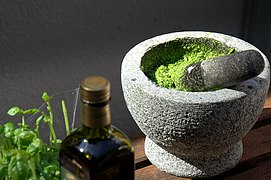 Pesto genovese
Pesto genovese
-
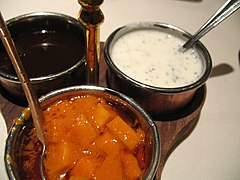 Chutneys
Chutneys
-
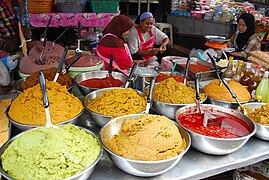 Curry powder or paste
Curry powder or paste
-
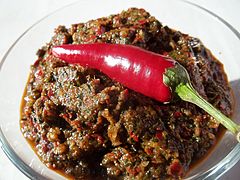 Ajika, spicy sauce in Caucasian cuisine
Ajika, spicy sauce in Caucasian cuisine
-
Tkemali (Georgian sauce made of sour cherry plums)
-
 Common Chinese condiments: soy sauce, vinegar, chili oil, white pepper
Common Chinese condiments: soy sauce, vinegar, chili oil, white pepper
-
 Packets of duck sauce
Packets of duck sauce
-
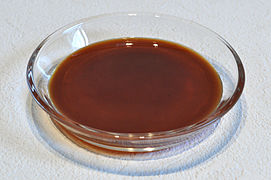 Worcestershire sauce
Worcestershire sauce
-
 Gentleman's Relish
Gentleman's Relish
-
 Acar and sambal, the common condiments in Indonesia
Acar and sambal, the common condiments in Indonesia
-
 Sriracha (type of hot sauce)
Sriracha (type of hot sauce)
-
 Shichimi
Shichimi
-
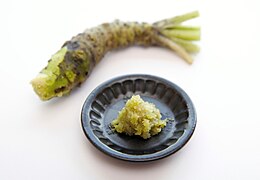 Wasabi
Wasabi
-
 Ssamjang
Ssamjang
-
 Hungarian Erős Pista
Hungarian Erős Pista
See also
- Condiments by country (category)
- Dip – Type of saucePages displaying short descriptions of redirect targets
- Garnish – Decoration added to food or drinkPages displaying short descriptions of redirect targets
- List of fish sauces
- List of foods – List of lists of food productsPages displaying short descriptions of redirect targets
- List of mustard brands
- Non-brewed condiment – Malt vinegar substitute
- Seasoning – Process of supplementing food via herbs, salts, or spices
- Herb – Plant used for food, medicine or perfume
- Spice – Food flavoring
- Relish – Cooked, pickled, or chopped vegetable or fruit used as a condiment
- Pickling – Procedure of preserving food in brine or vinegar
- Ingredient – Part of a mixture
References
Citations
- "Definition of Condiment". Merriam-Webster. 17 July 2024. Retrieved 24 July 2024.
- Collins: Definition Condiment
- ^ Farrell 1990, p. 291
- ^ Nealon 2010
- Smith 2007, pp. 144–146
- Farrell 1990, p. 297
- Freedman, Paul (2008). Out of the East: Spices and the Medieval Imagination. Yale University Press. pp. 3–4. ISBN 978-0-300-21131-3.
- ^ Sax, David (7 October 2010). "Spreading the Love". Bloomberg Businessweek. Archived from the original on 9 October 2010. Retrieved 9 October 2010.
Sources
- "Collins: Definition Condiment". Collins Dictionary. n.d. Retrieved 29 September 2014.
- Farrell, K. T. (1990). Spices, Condiments and Seasonings (2nd ed.). MA, USA: Aspen Publishers. ISBN 9780834213371.
- "Merriam-Webster: Definition of condiment". Merriam-Webster Dictionary. Retrieved 23 October 2011.
- Nealon, Tom (7 September 2010). "De Condimentis". HiLobrow. Retrieved 10 February 2014.
- Smith, Andrew F. (1 May 2007). The Oxford companion to American food and drink. Oxford University Press. ISBN 978-0-19-530796-2. Retrieved 15 March 2012.
External links
- [REDACTED] Media related to Condiments at Wikimedia Commons
Further reading
- Herbert, Amanda E; Bouchard, Jack B; Fine, Julia (3 June 2024). "Colonizing Condiments: Culinary Experimentation and the Politics of Disgust in Early Modern Britain". Global Food History: 1–30. doi:10.1080/20549547.2024.2357928.
| Condiments | ||
|---|---|---|
| Sauces |
|  |
| Dips | ||
| Pickles and preserves | ||
| Spreads and pastes | ||
| Oils and liquids | ||
| Spices and powders | ||
| Salads | ||
| Dressings | ||
| Ketchups | ||
| Mustards | ||
| Vinegars | ||
| List articles | ||
| Accoutrements | ||